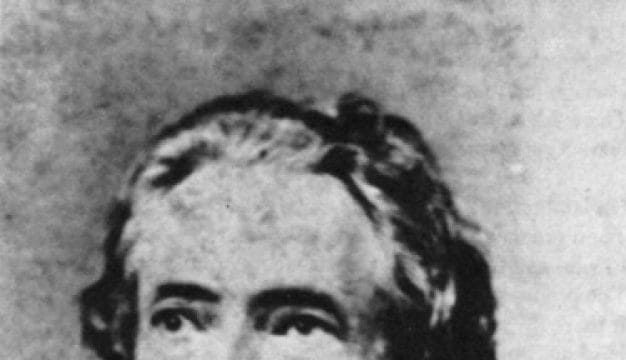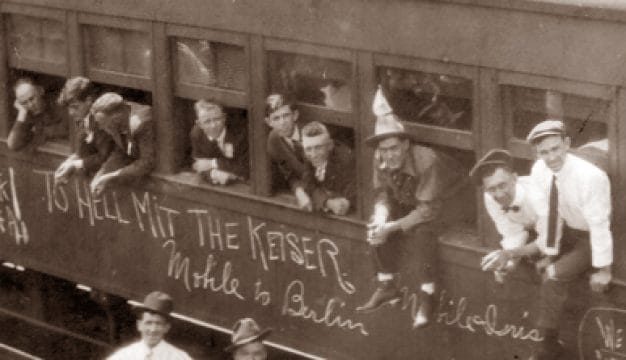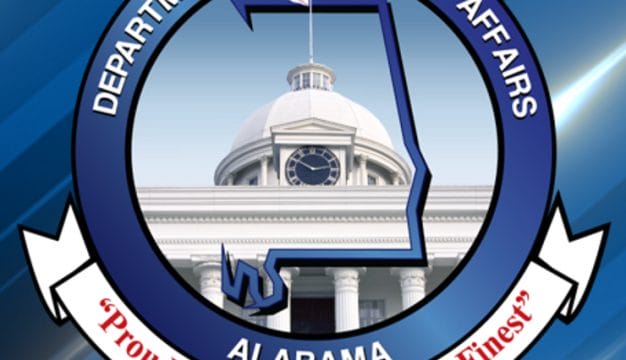Howard Finster
Self-taught folk artist and preacher Howard Finster (1916-2001), who was born and raised in Alabama, created fantastical paintings, sculptures, and environments that were inspired by religious visions he saw from the time he was a boy. He rose to national prominence during the 1980s and 1990s as a result of his involvement with popular music artists R.E.M. and the Talking Heads and increasing public interest in his Paradise Garden, a property near his Georgia home that he filled with art made from found objects. All of Finster’s art was informed by his deep religious faith and his desire to share that faith with others. Indeed, he saw this as his mission as “God’s Last Red Light on Planet Earth.”
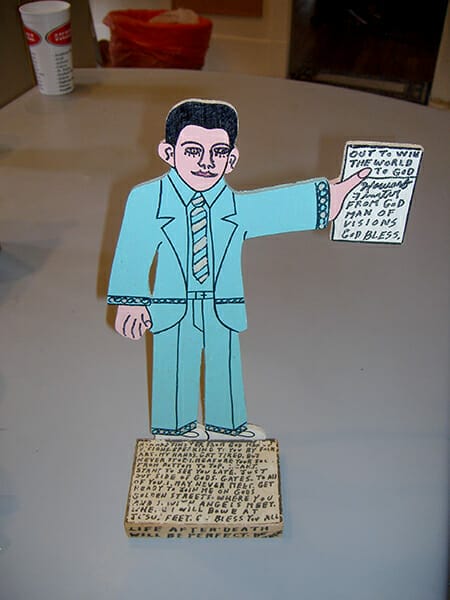 Howard Finster Self-portrait
One of 14 children, Howard Finster was born in Valley Head, DeKalb County, on December 2, 1916, to Samuel William Finster, a sawmill lumberjack, and Lula Alice Henegar Finster. At age three, Finster received the first of what would be many visions: his deceased sister, Abbie Rose, came to him on a floating stairway and told him that visions and other religious experiences would continue to play a vital role throughout his lifetime. At age 15, while riding on the back of a wagon, Finster received another vision in which God called on him to become a preacher. He soon began preaching at tent revivals all over Georgia, Alabama, and Tennessee. In 1935, Finster married Pauline Freeman, with whom he would have five children. In 1940, he became pastor of Rock Bridge Baptist Church near DeSoto State Park and also preached at other small country churches, baptized new members, and washed the feet of churchgoers. In the late 1940s, the Finster family relocated to Summerville, Georgia, near Valley Head.
Howard Finster Self-portrait
One of 14 children, Howard Finster was born in Valley Head, DeKalb County, on December 2, 1916, to Samuel William Finster, a sawmill lumberjack, and Lula Alice Henegar Finster. At age three, Finster received the first of what would be many visions: his deceased sister, Abbie Rose, came to him on a floating stairway and told him that visions and other religious experiences would continue to play a vital role throughout his lifetime. At age 15, while riding on the back of a wagon, Finster received another vision in which God called on him to become a preacher. He soon began preaching at tent revivals all over Georgia, Alabama, and Tennessee. In 1935, Finster married Pauline Freeman, with whom he would have five children. In 1940, he became pastor of Rock Bridge Baptist Church near DeSoto State Park and also preached at other small country churches, baptized new members, and washed the feet of churchgoers. In the late 1940s, the Finster family relocated to Summerville, Georgia, near Valley Head.
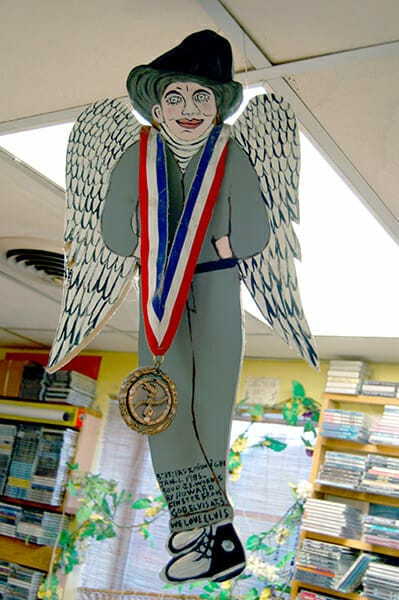 Howard Finster Angel
In 1961, Finster began to construct what would become his most famous accomplishment, the Plant Farm Museum House, or Paradise Garden, as it is more popularly known, near his home in Chatooga County, Georgia. Finster filled the space, previously used as a community dump, with multifaceted constructions made with items he rescued from the trash. These “found-object” sculptures and mosaics filled his new “Garden of Eden,” as he termed the space. Structures include the Mirror House, Hubcap Tower, Bicycle Tower, Bible House, and the World Folk Art Church and feature items such as bicycles, old jewelry, shoes, medical equipment, and anything else he could salvage. All of the themes in Finster’s garden environment are evangelical in nature and express his desire to bring his religious message to the public. He thus included hundreds of Biblical texts and mini-sermons in every space in the garden and its artworks. The site quickly became a popular local tourist destination.
Howard Finster Angel
In 1961, Finster began to construct what would become his most famous accomplishment, the Plant Farm Museum House, or Paradise Garden, as it is more popularly known, near his home in Chatooga County, Georgia. Finster filled the space, previously used as a community dump, with multifaceted constructions made with items he rescued from the trash. These “found-object” sculptures and mosaics filled his new “Garden of Eden,” as he termed the space. Structures include the Mirror House, Hubcap Tower, Bicycle Tower, Bible House, and the World Folk Art Church and feature items such as bicycles, old jewelry, shoes, medical equipment, and anything else he could salvage. All of the themes in Finster’s garden environment are evangelical in nature and express his desire to bring his religious message to the public. He thus included hundreds of Biblical texts and mini-sermons in every space in the garden and its artworks. The site quickly became a popular local tourist destination.
Finster continued preaching and working odd jobs until 1976, when he saw a vision of a face in a dab of paint on his thumb that commanded him to paint sacred art. He thereafter devoted his working life exclusively to painting and creating works of folk art. Many scholars and critics of art have compared his religious work to nineteenth-century tent-revival posters.
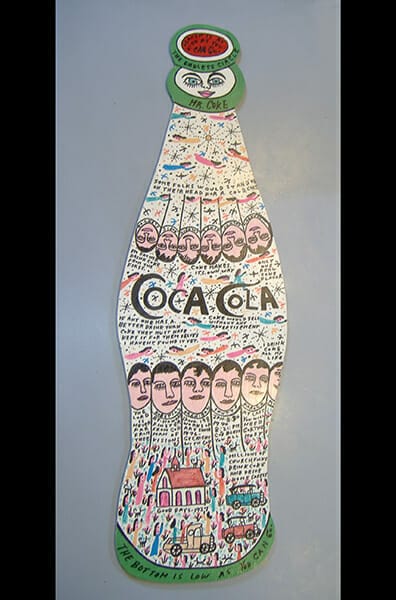 Howard Finster Coca-Cola Bottle
Finster’s imagery includes historical figures such as George Washington and Henry Ford, visions of heaven and hell, and life on other planets. He also painted popular images, including Marilyn Monroe, Elvis Presley, and Coca-Cola products, that served as an outlet for his sly sense of humor. These creations drew collectors and art historians, and many became as well known as his religious works. The most famous of these are probably his drawings of Coke bottles, which features slogans such as “Some people would stand on their heads all day for a cold Coke,” “Drink Coke—Drive Home Sober,” and “There are no Cokes in Hell.” In 1996, the Coca-Cola Company commissioned Finster to paint an eight-foot Coke bottle to represent the United States in an art exhibit for the 1996 Olympic Games.
Howard Finster Coca-Cola Bottle
Finster’s imagery includes historical figures such as George Washington and Henry Ford, visions of heaven and hell, and life on other planets. He also painted popular images, including Marilyn Monroe, Elvis Presley, and Coca-Cola products, that served as an outlet for his sly sense of humor. These creations drew collectors and art historians, and many became as well known as his religious works. The most famous of these are probably his drawings of Coke bottles, which features slogans such as “Some people would stand on their heads all day for a cold Coke,” “Drink Coke—Drive Home Sober,” and “There are no Cokes in Hell.” In 1996, the Coca-Cola Company commissioned Finster to paint an eight-foot Coke bottle to represent the United States in an art exhibit for the 1996 Olympic Games.
In the early 1980s, University of Georgia art professor Andy Nasisse championed Finster’s work and brought it to the attention of the members of Athens-based alternative-rock band R.E.M., who filmed the video for their single “Radio Free Europe” in Paradise Garden in 1983 and commissioned Finster to create a cover for their 1984 album Reckoning. Some conservative evangelicals condemned Finster for associating himself with rock music, but Finster countered by arguing that he used his art to spread his religious message, noting in a Birmingham Post-Herald interview in 1986, “You can’t win people by condemnin’ ’em.” In 1985, the band Talking Heads commissioned Finster to paint an image for the cover of their album Little Creatures, and it went on to win Rolling Stone magazine’s award for album cover of the year.
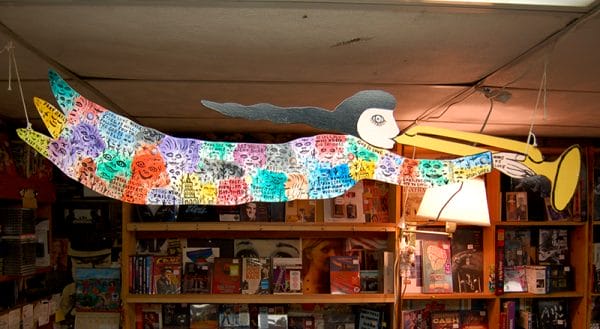 Howard Finster Trumpeting Angel
During the late 1980s and 1990s, Finster’s work garnered national and international attention. His artwork work was shown at the Library of Congress and the Smithsonian Institutution. Southern Living, Time, Life, and the New York Times published features on him, and he enjoyed the publicity. He always saw such exposure as opportunities to preach the gospel, however. He made appearances on television programs in the United States, Great Britain, Canada, and Japan and was invited to the White House as a guest of both Presidents Ronald Reagan and Bill Clinton. In December 1995, the High Museum of Art in Atlanta presented an exhibit of Finster’s work, and he was treated to a birthday party there during the exhibition. In spring 1996, he attended the dedication and opening of an exhibit of some of his Paradise Garden sculptures at the High Museum, for which portions of the garden were removed from Summerville and preserved for posterity in the museum. Despite declining health in the late 1990s, Finster continued to remain active at festivals and art shows throughout the South and welcomed visitors to Paradise Garden with a folk tune played on his banjo. In 1997, he attended an Elvis conference in Memphis, the Atlanta Folkfest, and the Kentuck Festival of the Arts in Northport, Tuscaloosa County, one of the premiere festivals for self-taught artists in the country. He was a popular lecturer and guest speaker at colleges and taught workshops at Paradise Garden for young people, through the Recycled Art Project, on ways to create artwork from found materials.
Howard Finster Trumpeting Angel
During the late 1980s and 1990s, Finster’s work garnered national and international attention. His artwork work was shown at the Library of Congress and the Smithsonian Institutution. Southern Living, Time, Life, and the New York Times published features on him, and he enjoyed the publicity. He always saw such exposure as opportunities to preach the gospel, however. He made appearances on television programs in the United States, Great Britain, Canada, and Japan and was invited to the White House as a guest of both Presidents Ronald Reagan and Bill Clinton. In December 1995, the High Museum of Art in Atlanta presented an exhibit of Finster’s work, and he was treated to a birthday party there during the exhibition. In spring 1996, he attended the dedication and opening of an exhibit of some of his Paradise Garden sculptures at the High Museum, for which portions of the garden were removed from Summerville and preserved for posterity in the museum. Despite declining health in the late 1990s, Finster continued to remain active at festivals and art shows throughout the South and welcomed visitors to Paradise Garden with a folk tune played on his banjo. In 1997, he attended an Elvis conference in Memphis, the Atlanta Folkfest, and the Kentuck Festival of the Arts in Northport, Tuscaloosa County, one of the premiere festivals for self-taught artists in the country. He was a popular lecturer and guest speaker at colleges and taught workshops at Paradise Garden for young people, through the Recycled Art Project, on ways to create artwork from found materials.
Finster died on October 22, 2001, of congestive heart failure and by that time had completed more than 46,000 pieces of art. Many of his works can be viewed in the High Museum of Art in Atlanta. In April 2011, Paradise Gardens was added to the National Register of Historic Places. Finster’s eccentric personality, prolific output, and critical and popular acclaim guaranteed him a place as one of the most celebrated self-taught artists of the twentieth century.
Additional Resources
Bradshaw, Thelma Finster. Howard Finster: The Early Years. Birmingham, Ala.: Crane Hill Publishers, 2001.
Finster, Howard, and Tom Patterson. Howard Finster, Stranger from Another World: Man of Visions Now on This Earth. New York: Abbeville Press, June 1989.
Peacock, Robert. Paradise Garden. San Francisco: Chronicle Books, 1996.

